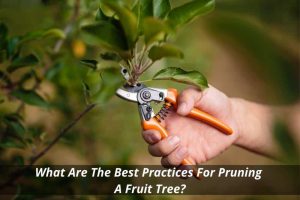Do you want to know what are the best practices for pruning a fruit tree? Pruning is a technique used to remove dead or damaged parts from trees. Pruning also helps improve the growth and health of plants. If done correctly, pruning can increase the lifespan of a plant.
When pruning a tree, you should always take into consideration the age of the tree, its size, and the type of pruning required. There are several types of pruning techniques, such as topiary, espalier, and coppicing. Each has its own benefits and drawbacks.
When pruning a fruit tree, you should aim to leave at least two buds per branch. This way, new branches will sprout after pruning. The goal is to create a symmetrical shape, where the branches meet at the same height.
Pruning service is one of the most important methods for controlling how trees grow and develop. In order for a tree to produce fruit and healthy flowers, it needs to be given enough light and space in which to spread out. Pruning allows the tree to reach this ideal state more quickly.
There are various reasons why you may want to prune your apple tree. Some of these include: removing old wood that has rotted; reducing branch overcrowding; improving the overall aesthetics of the tree; creating symmetry on the limbs; increasing the yield of apples; and preventing disease. Pruning an apple tree is a very delicate process. It requires a lot of skill and experience to ensure that you do not damage any part of the tree.
If you have young trees, make sure they receive plenty of sunlight when growing. You can achieve this by planting them near windows. You can also place them under shade cloths or use a reflective mulch to help maximize exposure to sunlight.
How To Grow Pineapples On Your Own Garden – Easy Tips And Tricks Of Growing Pineapples At Home
Do you love eating fresh pineapple? Then you must be looking for pineapples, right? But since you’ve grown tired of buying canned ones, here we’ll show you how to start growing pineapples!
In this guide, I’ll share with you all the easy tips and tricks for growing pineapples. These are tried and tested ways that have worked for me over the years.
Growing pineapples at home require a lot of patience and time, but with these simple steps, you too can enjoy delicious fresh pineapple every single day.
Before you begin, check the following things before getting started on the next step.
1. Water
It’s essential to water your pineapples. Do so regularly. As much as possible, keep watering during the summer.
Make sure to give your pineapples an ample amount of water during the entire growing season. If necessary, add some fertilizer to your soil.
2. Fertilizer
Fertilize your pineapples once a month. Try using fish emulsion. Apply about a 1-inch layer of the fertilizer directly onto the base of the trunk and leaves.
Also, apply about half of the fertilizer onto the roots while planting. Remember to avoid adding fertilizers to the soil around the root area.
3. Space
Plant your pineapples 12 inches apart. Keep in mind that spacing works differently depending on the variety of your pineapples. For example, dwarf varieties require less space than standard varieties.
4. Soil
Try using composted manure mixed with garden soil. Also, don’t forget to add some sand to the soil. By adding sand, you’ll prevent the soil from becoming compacted.
5. Time
Start growing pineapples in early April. Don’t wait until May as your pineapples won’t have a chance to mature. Instead, plant them between March to June.
6. Light
Planting pineapples in full sun will increase their growth rate. However, if you have limited space, try putting them inside underneath a greenhouse.
7. Temperature
The temperature inside your greenhouse should be set at 75 degrees Fahrenheit. This way, you’ll get sufficient warmth even during cold nights.
8. Harvest
Your first harvest will appear in August and September. After that, you can expect another harvest each fall. Continue harvesting throughout the winter months.
9. Diseases
Check for diseases like black spots. Use fungicides against them.
10. Pests
You should try keeping an eye out for pests such as leafhoppers. They can cause damage to your plants if not controlled properly.
What are some tips and tricks for pruning fruit trees?
Pruning is one of the most important tasks when it comes to maintaining healthy and productive trees. It also helps improve the overall appearance of your tree.
However, there isn’t just one type of pruning technique. There are many different types of pruning techniques. You need to know what kind of pruning technique is best suited for your particular needs.
Here are some of the most common types of pruning:
- Topiary – Topiary pruning involves shaping the top of the tree into the desired shape. This includes creating new shapes or eliminating old ones.
- Hedging – Hedge pruning involves removing unwanted woody stems from certain areas. This could include cutting off any branches that might interfere with your view.
- Training – Training is used to train branches to grow in specific directions. This means training branches to grow upwards or downwards.
- Deadwood Removal – Deadwood removal involves removing all the dead branches from the tree. Deadwood removal is usually done in late autumn.
- Staking – Staking is a form of support that keeps your tree upright. Stakes can help protect your tree from wind damage.
- Removals – Removals involve removing limbs, branches, or larger pieces of wood from your tree.
When choosing which type of pruning technique to use, consider these factors:
- Your budget – Some people prefer hedging because they think this method is more affordable. Others choose topiary because it gives them more control over their tree.
- How much time do you have – If you want to spend less time pruning, then hedging may be right for you. On the other hand, if you have lots of free time on your hands, then you may want to invest in a topiary kit.
- What kind of effect do you want – Do you want to create a formal look or would you rather let nature take its course?
These are just some examples of how you can prune your tree.
What tools should be used when pruning fruit trees?
There are several tools that you can use when pruning your tree. These include:
- Hand saws – A hand saw is good for cutting through thick branches. However, make sure that you don’t cut too deeply. Otherwise, you risk damaging the trunk.
- Pole saws – Pole saws are great for cutting smaller branches. They come with a pole that allows you to reach higher up.
- Pole pruners – Pole pruners are similar to pole saws but they allow you to work closer to the ground. This makes them easier to use than pole saws.
- Chainsaws – Chainsaws are very useful for removing large branches. Make sure that you only use chainsaws that have been designed specifically for pruning trees.
- Shovels – Shovels are helpful for digging out the soil around the base of your tree. This will prevent your tree from getting waterlogged during winter.
What is a fruit tree pruner?
A fruit tree pruner is someone who has been trained to remove excess branches and debris from fruit trees. When you hire a fruit tree pruner, you get the benefit of having an expert remove those pesky branches and leaves that could otherwise block light and air.
How does a fruit tree pruner differ from a regular gardener?
While both gardeners and fruit tree pruners perform similar tasks, there are key differences between the two. Gardeners typically focus on keeping plants healthy while fruit tree pruners specialize in pruning fruit trees.
In addition to being experts at pruning fruit trees, fruit tree pruners also tend to be more knowledgeable about the health of your tree. This is because they are able to see things like whether the tree needs fertilizer or not.
Why is pruning necessary?
Pruning is important because it helps keep your tree looking beautiful and well-maintained. It also prevents problems such as disease and insect infestations.
How often should I prune my fruit tree?
The length of time you need to prune your fruit tree depends on what you want to achieve. You can prune your tree whenever you feel like doing so. However, most people recommend tree pruning and trimming in early spring before new growth begins.
If you are planning on growing apples, pears, peaches, plums, cherries, apricots, nectarines, or strawberries, then you should prune your tree every year.
If you want to produce a specific type of fruit, such as blueberries, raspberries, or blackberries, then you might need to prune your tree twice per season.
When pruning your tree, you should always follow these steps:
1) Remove all damaged parts of the tree.
2) Cut back any branches that are crossing over and blocking sunlight.
3) Trim away any branches that are touching each other.
4) Use a sharp knife to cut off any dead wood.
5) Prune away any suckers that have sprouted from the root system.
6) Reposition any limbs that are leaning against walls or fences.
7) Prune away any branches that have grown too close together.
8) If you notice any diseased spots on your tree, remove them immediately.
9) Be careful when using power tools. Always wear protective gear such as gloves, goggles, and ear protection.
10) If you are going to leave your tree standing after pruning, make sure that you cover it with mulch or grass clippings. Mulching will help protect your tree from damage during the winter months.

